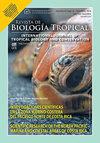厄瓜多尔安第斯山脉帕拉莫景观中猛禽的群落结构
IF 0.6
4区 生物学
Q4 BIOLOGY
引用次数: 0
摘要
引言:生境的改变导致生物多样性的丧失,特别是在多样性和地方性较高的地区。猛禽是生态系统功能和稳定性的重要组成部分,也是栖息地质量的指标。在南美洲北部安第斯山脉的帕拉莫草原生态系统中,猛禽含有大量受威胁物种。目的:描述猛禽群落结构,确定猛禽的物种组合。方法:从2021年10月到2022年9月,我们对8个样带的猛禽进行了月度计数,并使用主成分分析来确定物种关联。结果:我们在两个群落中鉴定了149个个体(7种,3科):丰富(Carunculated Caracara,Variable Hawk,安第斯秃鹰和土耳其秃鹫;PCI=47%)和稀少(Cinereous Harrier,Peregrine Falcon和Aplomado Falco;PCII=27%)。结论:我们对猛禽群落结构提供了有效的描述和理解,确定了两个群落及其之间的动态。第一个群落的特征是多面手和区域常见物种的丰度增加,当这些物种的丰度减少时,第二个群落被定义,其特征是在当地范围内专业和稀有物种的丰度上升。本文章由计算机程序翻译,如有差异,请以英文原文为准。
Community structure of raptors in the páramo landscape of the Ecuadorian Andes
Introduction: Habitat alterations result in biodiversity loss, particularly in regions with high levels of diversity and endemism. Raptors are an essential part of the functionality and stability of ecosystems and indicators of habitat quality. In the paramo grassland ecosystems in the high Andes of Northern South America, raptors contain a high concentration of threatened species. Objective: To describe the raptor community structure and determine the species associations. Methods: We made monthly raptor counts in eight transects from October 2021 to September 2022 and used a principal component analysis to determine species associations. Results: We identified 149 individuals (seven species, three families) in two communities: abundant (Carunculated Caracara, Variable Hawk, Andean Condor and Turkey Vulture; PCI = 47 %), and scarce (Cinereous Harrier, Peregrine Falcon and Aplomado Falco; PCII = 27 %). Conclusion: We provide a valid description and understanding of raptor community structure, identifying two communities and the dynamics between them. The first is characterized by an increased abundance of generalist and regionally common species, when the abundance of these species decreases, the second community is defined, characterized by an increase in the abundance of specialist and rare species at the local scale.
求助全文
通过发布文献求助,成功后即可免费获取论文全文。
去求助
来源期刊

Revista De Biologia Tropical
生物-生物学
CiteScore
1.80
自引率
0.00%
发文量
23
审稿时长
4-8 weeks
期刊介绍:
The Revista de Biología Tropical / International Journal of Tropical Biology and Conservation is a mainstream scientific journal published since 1953 and covered by Web of Science; Science Citation Index; Current Contents; Google Scholar; Scopus, SciELO and nearly 50 additional indices.
A double blind system guarantees you a fair evaluation, and our world class editorial and scientific boards provides a first decision in three working days. The journal is Full Open Access and is widely read where your article can have the highest real impact.
Since its beginning in 1953, the Revista follows these principles: objective and independent evaluation of all manuscripts; transparency in all processes; ethical use of procedures, data, specimens and subjects; fair treatment of all parties; and absolute predominance of scientific rigor over any other aspect.
 求助内容:
求助内容: 应助结果提醒方式:
应助结果提醒方式:


